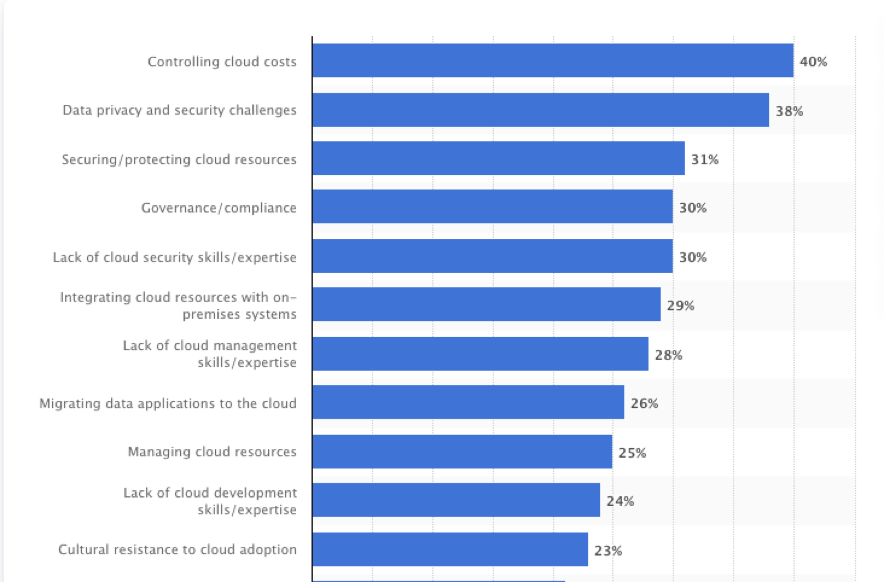While working in the cloud, various factors lead to escalating cloud costs. That’s why cloud cost management is important. The procedure helps manage various facilities, such as software applications, virtual machines, and storage, directly adding to operating expenses.
A study done by Statista had more than 40 percent of respondents saying cloud cost control was the biggest cloud adoption challenge.

To explain further, respondents prioritized cost control — more priority than security, skills, and cloud privacy concerns.
This blog will identify major factors to help you in cloud cost management. These factors can lead to escalating cloud costs. We’ll discuss three critical cloud cost control strategies. But first:
An Overview of Cloud Cost Management
Cloud cost management is any strategy a company uses to understand and manage cost factors within the cloud. As a result, companies can manage their resources more effectively by channeling their budgets on more important cloud assets. In large enterprise organizations, decision-making is usually slow. But cloud costs are ever-changing. Again, the cloud uses a pay-as-you-go model, while SAAS uses a subscription model. So, how do you balance the cash flow? The best way to manage cloud costs is to set a criterion that saves you time.
It’s equally important to understand factors contributing to skyrocketing cloud costs.
Each cloud service provider has different pricing plans. An expensive vendor may offer quality services faster. But the option may be pricey.
- SAAS businesses can choose from a variety of cloud vendors. They can choose Microsoft Azure, AWS, Google cloud, and much more. The pricing plan you choose when signing up will affect future cloud costs. Each cloud company has a different price per instance.
- The size of data, the extent of server space, and networking requirements will affect cloud costs.
- Since the cloud uses a pay-as-you-go model, time will also affect cloud costs.
Three Critical Cloud Cost Management Tips for SaaS
With these factors in mind, companies can use the following tips to control their cloud costs.
1. Assign Usage-Based Roles
Usage-based roles are permissions that control access to the cloud. SAAS organizations can create access rights on cost management. Instead of letting only the finance guy have access to cost-management tools, create more cost-control access rights. That way, everyone can proactively control costs.
2. Allocate Budgets, Don’t Estimate
A typical way of creating budgets is to identify cloud resources and estimate an approximate cost. That might work for an on-premises environment. But with the cloud, costs can be more volatile. So an estimated budget may not be accurate. The best practice is to monitor your cloud expenditure over time. Note the tools you frequently use, the most frequent operations, most productive processes, and much more. Study cloud reports and identify the most productive activities. Then allocate a budget based on your spending activity. You may find out that some departments spend more than others, or some cost centers need more budget than others. This budgeting approach optimizes your cloud expenditure by making SAAS companies spend on productive resources.
3. Use Cloud Cost Management Tools
Cloud Cost Management Tools are simply software made to track and monitor how you spend company resources in the cloud. How do the tools work? They can be simple tools alerting you of unusual cloud activities. Users can then log in and optimize their costs manually. Other times, cost control software can optimize the cost on your behalf.
SAAS businesses on AWS can use Amazon CloudWatch to control cloud costs. It monitors cost factors in your AWS infrastructure. ParkMyCloud is another tool SAAS businessmen can leverage to get rid of nonproductive cloud expenditure in Microsoft Azure. The tool is also compatible with Google cloud.
The Bottom Line
Cloud cost management is a long-term process. It involves doing many little things, such that, when combined, can significantly reduce cloud costs. Make sure you have enough visibility of your SAAS cost center. Use the tips in this blog post. They’re practical across all major cloud providers.
If you need help controlling your cloud costs, don’t hesitate to contact us at https://nops.io/.



